Introduction
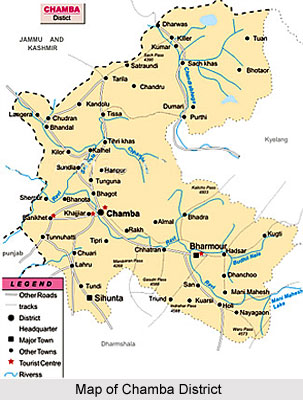 Chamba District is an administrative district of Himachal Pradesh with its headquarters at Chamba town. Chamba District covers an estimated area of 6528 sq kms and is surrounded on all sides by lofty hill ranges. The territory is wholly mountainous with altitude ranging from 2,000 to 21,000 feet. Total population of Chamba District is 460,499 according to Census 2001. The climate of Chamba District ranges from semi-tropical to semi-arctic.
Chamba District is an administrative district of Himachal Pradesh with its headquarters at Chamba town. Chamba District covers an estimated area of 6528 sq kms and is surrounded on all sides by lofty hill ranges. The territory is wholly mountainous with altitude ranging from 2,000 to 21,000 feet. Total population of Chamba District is 460,499 according to Census 2001. The climate of Chamba District ranges from semi-tropical to semi-arctic.
History of Chamba District
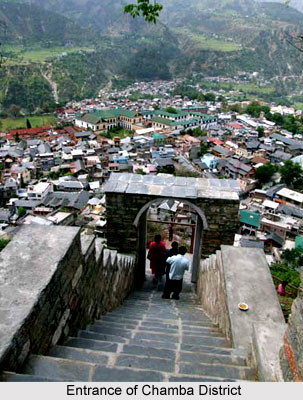 According to the early history of Chamba District it is believed that this area was at one time inhabited by Koli tribes. However, it was later, conquered by the Khasas. The Khasas too after a time came under the sway of Audumbaras (2nd century BC). The Audmabaras had republican form of government and they worshiped Lord Shiva. From the Gupta period (4th Century AD), Chamba region was under the control of Thakurs and Ranas who considered themselves superior to the low Koli tribe and Khasas. With the rise of Gurjara Pratiharas (7th Century AD), Rajputs came to power.
According to the early history of Chamba District it is believed that this area was at one time inhabited by Koli tribes. However, it was later, conquered by the Khasas. The Khasas too after a time came under the sway of Audumbaras (2nd century BC). The Audmabaras had republican form of government and they worshiped Lord Shiva. From the Gupta period (4th Century AD), Chamba region was under the control of Thakurs and Ranas who considered themselves superior to the low Koli tribe and Khasas. With the rise of Gurjara Pratiharas (7th Century AD), Rajputs came to power.
Further, the history of Chamba District states that in around 500 AD, a legendry hero called Maru migrated to north-west from Kalpagrama (a mythical place from where majority of the Rajput dynasties claim their descent). His successors continued to rule over the country from that capital city for over three hundred years until Sahilla Varman shifted his capital from Brahmaputra to the centrally located plateau in the lower Ravi valley. He named the town after his beloved daughter Champa. The layout of the plan of Chamba seems to be in conformity with the ancient texts. From then on the rajas of Chamba continued to rule from here in an uninterrupted and direct line of descent. Chamba is the only state in northern India to preserve a well-documented history from approximately 500 AD. Its high mountain ranges have given it a sheltered position and helped in preserving its centuries old relics and numerous inscriptions. The temples erected by rajas of Chamba more than a thousand years age continue to be under worship and the land grant-deeds executed on copper plates by them continue to be valid under the law.
Interestingly, the Muslims never invaded Chamba, though it had its occasional fights with the neighbouring states in the hills having similar cultural background. Thus, the damage to Chamba from these invasions was seldom serious and never beyond the possibility of repair. Even the powerful Mughals were kept at bay on account of difficulties involved in communications and long distances. Akbar tried to extend a loose control over the hill states including Chamba and attached fertile tracts of these states to the imperial territory south of Dhauladhar. Aurangzeb once issued orders to the Raja of Chamba Chatter Singh (1664-1694 AD) to pull down the beautiful temples of Chamba. But instead the raja in clear defiance to the Mughal ruler placed glided pinnacles on the temples. He was ordered to come down to Delhi to face the imperial wrath. But Aurangzeb himself had to leave for the Deccan from where he could not disentangle till the end of his life. On the whole, northern India experienced comparatively peaceful condition during the Mughal regime Raja Prithvi Singh (1641-1664 AD), visited the imperial court many times. He introduced the Mughal style of court life including Mughal-Rajput art and architecture in Chamba.
By the last quarter of 18th century the Sikhs forced the hill states to pay tribute to them. After Ranjit Singh`s death, Chamba became un-protected and was drawn into the vortex of the disintegration of the Sikh Kingdom. The Sikh army invaded the British territory in the year 1845 and the troops of Sikh army, which were stationed in Chamba, were withdrawn. When Sikh`s were defeated it was decided to merge Chamba in Jammu and Kashmir but on account of the timely intervention of Wazir Bagha (of Chamba) it was taken under the British control.
On 15th of April, 1948 merging three principal states namely Chamba, Mandi-Suket, Sirmour and all the other state falling in Shimla hills formed Himachal Pradesh. Subsequently, for better administration Chamba was divided into five zones known as Mandlas. These Mandlas were later reamed as Wizarats. This five fold division of Chamba region continues till today. The Wizarats are now called Tehsils. These are Bharmaur, Chamba, Bhattiyat, Churah and Pangi.
Geography of Chamba District
Chamba District is situated between 32 degree 11 minutes 30 seconds and 33 degree 13 minutes 6 seconds north latitude and 75 degree 49 minutes and 77 degree 3 minutes 30 seconds east longitude. Chamba District is bounded on north-west by Jammu and Kashmir, on the north-east and east by Ladakh and Lahul and Bara-Bangal area, on the south-east and south by Kangra and Gurdaspur District of Punjab.
Tourism in Chamba District
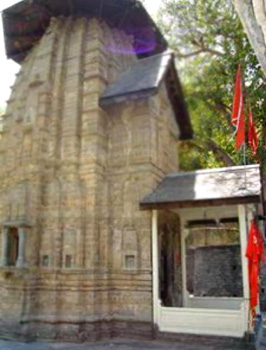 Tourism in Chamba District includes visits to several religious sites as well as historical spots. Tourism in this district of Himachal Pradesh is mainly popular for its temples. There are various renowned temples located here. Here, the travellers get the opportunity to explore several ancient forts too. Scenic beauty of the surrounding hills adds charm to the tourism experience. Some of the main attractions of Chamba District are as follows -
Tourism in Chamba District includes visits to several religious sites as well as historical spots. Tourism in this district of Himachal Pradesh is mainly popular for its temples. There are various renowned temples located here. Here, the travellers get the opportunity to explore several ancient forts too. Scenic beauty of the surrounding hills adds charm to the tourism experience. Some of the main attractions of Chamba District are as follows -
Pilgrimage Tourism in Chamba District -
Kunjar Mahadev: Kunjar Mahadev is a great pilgrimage centre situated in Tundi pargana of Sihunta sub-tehsil. This place attracts the attention of a large number of people from all parts of the country.
Laxmi Narayan Temple: Laxmi Narayan Temple, which is the main temple of Chamba town, was built by Sahil Verman in the 10th century AD. The temple has been built in the Shikhara style. This temple consists of Bimana. Laxmi Narayan Temple has a Mandapa like structure also. There are several other temples within this complex.
Champavati Temple: This temple was built by Raja Sahil Varman in memory of his daughter Champavati who is believed to have influenced her father to set-up Chamba at its present location. The temple is in the Shikhara style with elaborate stone carving and the wheel roof. The size of this temple is equivalent to the largest of Laxmi Narayan Temple.
Vajreshwari Temple: This ancient temple is believed to be 1000 years old and is dedicated to Devi Vajreshwari. The temple is situated on the northern most corner of the town at the end of Jansali Bazaar. However, no historical record of the temple is available. The temple is built in the Shikhara style that is elaborately carved. There are two other minor temples on either side of the main shrine.
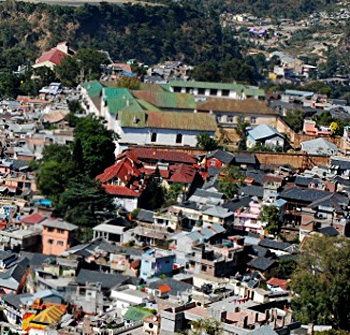 Chamunda Devi Temple: This temple is located on the spur of the Shah Madar Hill overlooking the town to its south east. The temple stands on a raised platform. The temple has artistic carvings on its lintel, pillars and the ceiling. Behind the main temple is a small shrine of Lord Shiva in the Shikhara style. There is another platform in front of this temple where two very old Peepul trees provide shelter to the visitors. From this platform the visitors can have a bird`s eye view of most of the land marks in the town including Chaugan, Circuit House, most of the temples and Ravi River. The temple is being looked after by Archaeological Survey of India. The temple has an easy approach.
Chamunda Devi Temple: This temple is located on the spur of the Shah Madar Hill overlooking the town to its south east. The temple stands on a raised platform. The temple has artistic carvings on its lintel, pillars and the ceiling. Behind the main temple is a small shrine of Lord Shiva in the Shikhara style. There is another platform in front of this temple where two very old Peepul trees provide shelter to the visitors. From this platform the visitors can have a bird`s eye view of most of the land marks in the town including Chaugan, Circuit House, most of the temples and Ravi River. The temple is being looked after by Archaeological Survey of India. The temple has an easy approach.
Hari Rai Temple: This temple is dedicated to Lord Vishnu. This temple lies in the north-west corner of the main Chaugan, which had become the official entrance to the town by the end of 19th Century AD. A steep path leads to the old Shitla Bridge, which was constructed in the year 1894. The temple is built in Shikhara style and stands on a stone platform. The Shikhara of the temple is finely carved. This is one of the major old temples, which is away from the old township and the only one near the Chaugan. Much of this temple is hidden behind some unimaginative structures of the British period behind the Gandhi Gate and the Fire Station Building. The temple enshrines a marvellous bronze image of Lord Vishnu in the form of Chaturmurti. The temple of Hari Rai is believed to be of great antiquity and legend affirms that the Ravi once flowed in a shallow stream across the Chaugan and the temple had to be approached by stepping.
Dayanand Math, Chamba: Dayanand Math based on the principals of Arya Samaj is functioning in Chamba since 1970. Dayanand Math is a great religious centre of the district. People from far and wide visit the place for their spiritual gratification.
Leisure Tourism in Chamba Distric -
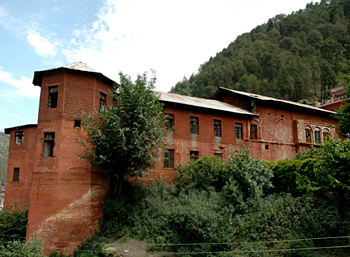 Ardha Gaya: There is a bowli (water reservoir) situated within the Chaurashi area. Besides being a great water source, it is also said to have a holy significance and is called Ardha Gaya. There is an interesting legend about this bowli. Once in the hoary past, Lord Shiva accompanied by Parvati and their son Ganesha were strolling at this place. Parvati remembered that the day was auspicious for having a dip in the holy water at Gaya. So, she longed to go there but Lord Shiva expressed his inability to fulfill her desire. Parvati was disappointed. Finding his mother distressed, Lord Ganesha shot an arrow at the spot and water gushed out from seven spouts. It is believed that this bowli is made up of waters of all holy rivers and springs of India and a dip would wash of all sins. It was therefore named as Ardh Gaya meaning half as sacred as Gaya.
Ardha Gaya: There is a bowli (water reservoir) situated within the Chaurashi area. Besides being a great water source, it is also said to have a holy significance and is called Ardha Gaya. There is an interesting legend about this bowli. Once in the hoary past, Lord Shiva accompanied by Parvati and their son Ganesha were strolling at this place. Parvati remembered that the day was auspicious for having a dip in the holy water at Gaya. So, she longed to go there but Lord Shiva expressed his inability to fulfill her desire. Parvati was disappointed. Finding his mother distressed, Lord Ganesha shot an arrow at the spot and water gushed out from seven spouts. It is believed that this bowli is made up of waters of all holy rivers and springs of India and a dip would wash of all sins. It was therefore named as Ardh Gaya meaning half as sacred as Gaya.
Akhand Chandi Palace: Construction of this residential building of the Chamba family was started by Raja Umed Singh sometimes in between 1748 to 1764 AD. The place was rebuilt and renovated during the reign of Raja Sham Singh with the help of British engineers. The Darbar Hall (Marshal Hall) was built in 1879 by Captain Marshal and the Zanana Mahal was added in the reign of Raja Bhuri Singh. The subsequent additions and alterations clearly betray the Mughal and the British influence. In 1958 the Palace building was sold by the descendants of the royal family to the Himachal Government. The latter handed it over to the Education Department for the purpose of starting a Government College and District Library. The beautiful structures of the palace with its painted walls and glass work, ceiling, intricate woodwork are fast deteriorating. The palace has a commanding view of the Chaugan, Laxmi Narayana Temple, Sui Mata Temple, Chamunda Devi Temple, Rang Mehal, Hari Rai Temple and Bansi Gopal Temple.
Rang Mahal: It is one of the largest monuments of Chamba District and is located in Surara Mohalla. The foundation of Rang Mahal was laid by Raja Umed Singh (1748-1764 AD). The architecture of Rang Mahal is an amalgam of Mughal and British styles. This palace was the residence for a branch of the ruling family. Its fort like look justifies its use as royal granary and treasury which is on its western side. A number of decorative and colorful wall paintings have been removed and taken to National Museum, New Delhi. Some of the wall paintings and richly painted doors of the palace can be seen preserved in the Bhuri Singh Museum of Chamba.
Bhuri Singh Museum: Bhuri Singh Museum at Chamba opened formally on 14th of September, 1908. It is named after Raja Bhuri Singh who ruled Chamba from 1904 to 1919. Bhuri Singh donated his family collection of paintings to the museum. There are collections of coins, hill jewelleries and costumes both traditional and royal, arms and armour, musical instruments and various decorative objects.
Nature Tourism in Chamba District -
Art Garden: This site is located at the entrance of the town on the bed of Ravi River. This site has been built by the Department. It is a good picnic spot.
Rock Garden: This site is located on main road from Banikhet to Chamba at a distance of 10 kms from Banikhet. It is just near the Devi Dehhra temple and is located on both sides of the main road.
These are some of the major tourist attractions of Chamba District and are worth seeing.
Temples of Chamba District
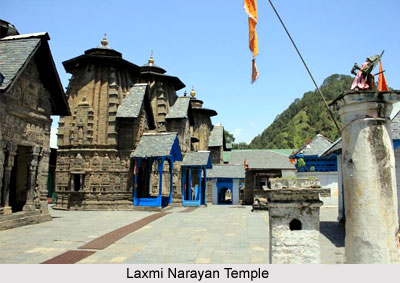 There are several popular temples in Chamba District. Visits to the temples of this district of Himachal Pradesh offer an enriching religious experience. Some of the ancient temples of Chamba District reflect the deep religions and legends associated with their foundations. Laxmi Narayan Temple, Vajreshvari Temple, Chamunda Devi Temple, Chhatrari Devi Temple are some of the popular temples of Chamba District. A brief description about them is given below -
There are several popular temples in Chamba District. Visits to the temples of this district of Himachal Pradesh offer an enriching religious experience. Some of the ancient temples of Chamba District reflect the deep religions and legends associated with their foundations. Laxmi Narayan Temple, Vajreshvari Temple, Chamunda Devi Temple, Chhatrari Devi Temple are some of the popular temples of Chamba District. A brief description about them is given below -
Laxmi Narayan Temple: Laxmi Narayan Temple, which is the main temple of Chamba town, was built by Sahil Verman in 10th century AD. The temple has been built in Shikhara style. The temple has a mandapa like structure also. The wooden Chhattries, the wheel roof, atop the temple were in response to the local climatic conditions as a protection against snow-fall. There are several other temples within this complex. The temple known as Radha Krishan was erected as late as 1825 AD by. The Shiva temple of Chandragupta Maurya was also believed to have been built by Raja Sahil Verman. The temple of Lakshmi Narayan continued to be embellished by the Rajas who succeeded to the throne of Chamba. Raja Balabhadra Verma perched the metallic image of Garuda on a high pillar at the main gate of the temple. Raja Chhatra Singh placed gilded pinnacles on the temple tops in 1678 as a reaction against the orders of Aurangzeb to demolish the temple. Later Rajas also added a shrine or two thus enriching the complex.
Champavati Temple: The temple of goddess Champavati is shikhara style stands near the royal place. Tradition holds it that this temple was made in the name of Raja Sahil Verman`s daughter Champavati.
Vajreshvari Temple: Vajreshwari Temple is also of shikhara style built in stone at the entrance of Sarota outside the town dedicated to goddess Vajreshwari. It is known for its fine sculpture. It is believed to have been erected in the eleventh century AD. There is a short tree-line inscription carved on one of the two pillars in front of the entrance of the shrine. There are eighteen brief one-line epigraphs on the outer walls of the temple. The temple pillars are beautifully carved depicting various deities on them. The temple has a stone image of Mahishasura Mardini.
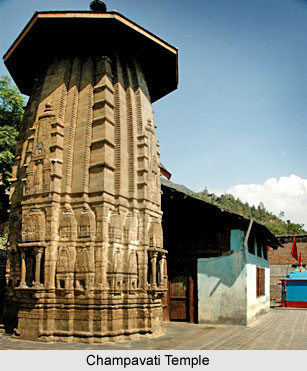 Chamunda Devi Temple: This temple is dedicated to Chamunda. This temple is made in hill type architecture. It stands on small spur of Shah Madar hill. A beautiful and holistic view of Chamba town is obtained from the premises of the temple. It has pent-roof of ordinary type of temples in the area but has beautiful wood carvings preserved in it. In the ceiling several panels have been carved which make the temple artistically important.
Chamunda Devi Temple: This temple is dedicated to Chamunda. This temple is made in hill type architecture. It stands on small spur of Shah Madar hill. A beautiful and holistic view of Chamba town is obtained from the premises of the temple. It has pent-roof of ordinary type of temples in the area but has beautiful wood carvings preserved in it. In the ceiling several panels have been carved which make the temple artistically important.
Hari Rai Temple: Shri Hari Rai temple (Vishnu temple) is located near Chaugan gate. The temple is in shikhara style built in stone.
Bansi Gopal Temple: This temple is also of shikhara style and is situated in the vicinity of Chamba palace. This temple is dedicated to Lord Krishna whose image holding a flute is enshrined with Radha. In copper plate of Raja Balbhadra issued in AD 1595, mention is made of this temple. The entrance gate of the temple depicts Ganga and Yamuna standing holding a vase.
Chandershekhar Temple at Saho: There is a beautiful temple devoted to Lord Chandershekhar in the heart of Saho village. According to one belief, this temple was constructed by Raja Sahil Varman and according to another belief; the temple was constructed by Satyaki, son of King Bhagota. The temple is not only a popular pilgrimage centre but also a centre for all social gatherings like fairs and festivals.
Vishnu Temple, Saho: A small shrine opposite the temple of Chandershekhar of Saho is dedicated to Lord Vishnu.
Bhader Kali Temple: The temple of Bhader Kali popularly known as Sri Bhalei Mata is located at Bhalei which is now a sub-tehsil headquarters. According to legends, the temple of Bhadar Kali seems to have been built originally by Raja Pratap Singh during his reign.
Chhatrari Devi Temple: In the heart of Chattrari village is the famous temple of Adashakti, more popularly known as Chattrari Devi temple. Chattrari temple is regarded as one of the holiest places of the hills. It is one of the oldest temples. Tradition attributes its foundation to Mushan Varman. But the inscription on the temple mentions that Meru Varman built the temple in 700 AD.
Manimahesh Temple, Bharmaur: This is one of the most famous temples of the district. The temple is in shikhara style dedicated to Lord Shiva. These temples of Chamba District offer a memorable experience to the travellers and they are worth visiting.
History of Temples of Chamba District
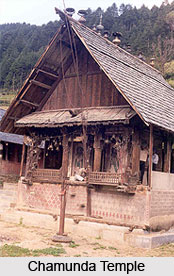 The temples of Chamba District have been mostly built by the enlightened and religious rulers of Chamba. Raja Meru Varman flourished near about A.D. 700. The earlier king Maru Varman could be described as the historical predecessor of Meru Varman and he founded the town of Brahmapura and made it the capital of the new State. Meru Varman later extended the limits of the state by conquests. In gratitude of his conquests inscriptions have been engraved of Meru Varman at Chatrari dedicated the idol of Shakti Devi. Another inscription recorded by a feudatory of Meru Varman, named Ashadha can be seen at Gun village.
The temples of Chamba District have been mostly built by the enlightened and religious rulers of Chamba. Raja Meru Varman flourished near about A.D. 700. The earlier king Maru Varman could be described as the historical predecessor of Meru Varman and he founded the town of Brahmapura and made it the capital of the new State. Meru Varman later extended the limits of the state by conquests. In gratitude of his conquests inscriptions have been engraved of Meru Varman at Chatrari dedicated the idol of Shakti Devi. Another inscription recorded by a feudatory of Meru Varman, named Ashadha can be seen at Gun village.
Temples built by Chamba Rulers
The Chamunda Temple at Devi Kothi, in Himachal Pradesh was built by Raja Umed Singh in 1754 A.D. the temple is important for the influence of the Mughal Dynasty in its structural patterns and in wood carving. The same influence can be depicted in some of the profane buildings of that period, like the State Kothi at Brahmaur ascribed to Raja Prithi Singh. The building was however destroyed in the earthquake on 4th April, 1905. Specimens of modern wood-carvings can be seen at Mindal, opposite Sach, on the temple of Chamunda (commonly called Mindal Devi) and on the little Naga temple near Kilar.
Meru Varman had extended his sway to Kullu State. One can see a long inscription on the pedestal of the brazen Nandi bull in front of the Mani Mahesa temple. Apart from these there are other two inscriptions in the temple of Lakshana Devi and Ganesa that ascribe the dedication of the idols to King Meru Varman. The temple known as Suraj-Mukha shrine contained the patron deity of Chamba Raja. This temple was also built by Meru Varman.
Sahila Varman another king of Chamba founded the new capital town of Chamba and shifted the capital there. He had sacrificed his daughter Champavati which is commemorated by the Chamasni temple erected by the king. The annual Suhi Mela is also celebrated to commemorate the sacrifice of Champavati. During the fair women assemble to sing her glory, devotion and sacrifice. The annual mela is celebrated for about twenty-one days from the 1st to the 21st Baisakh. This celebration has made the temple popular among the people. Sahila Varman is also credited with building few more temples as well as the original palace at Chamba.
The rulers of Chamba are also remembered for their patronage of the artists who excelled in the art of wooden architecture and Paharia-paintings on the walls and roofs. Apart from the paintings on the walls or ceilings of the temples there are many other old paintings on mythological and other subjects at the Bhuri Singh Museum.
There are also portraits and miniature paintings. Some of the rooms in the palaces have still wonderful decorations with oil paintings on the walls. It appears that when the artists had to leave Delhi, Agra and other places better known for art due to persecution of some of the Mughal Kings these smaller ruling princes in Himachal area gave them shelter and patronage. For our purposes only a mention to the wall paintings etc., as decorations on temples or other places is necessary as mostly the themes are old religious stories, mythological tales, shikhar and love dalliances of Lord Krishna, Radha and gopinis etc.
Fairs in Chamba District
Fairs in Chamba District of vast popularity are organized on different occasions. Jatra is a local name given to the popular fairs in Chamba District. Various Yatras are observed in Chamba town and elsewhere in the district. The general feature of Yatras is worship of any deity and offering prayers. The folk dance and folk songs are the main attractions of these fairs attended by a large number of people from far and wide. Some of the main fairs of Chamba District are mentioned below -
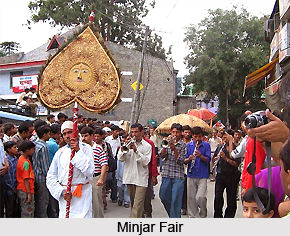 Minjar Fair: Minjar is the most popular fair of Chamba which is attended by a large number of people from every nook and corner of the district. This mela is held on the second Sunday of Shravana month. The fair is announced by distribution of Minjar which is a silk tassel worn by the people here. The town of Chamba wears a colourful look during this time. Sports and cultural programmes are organised. Minjar fair has been declared as one of the state fairs of Himachal Pradesh.
Minjar Fair: Minjar is the most popular fair of Chamba which is attended by a large number of people from every nook and corner of the district. This mela is held on the second Sunday of Shravana month. The fair is announced by distribution of Minjar which is a silk tassel worn by the people here. The town of Chamba wears a colourful look during this time. Sports and cultural programmes are organised. Minjar fair has been declared as one of the state fairs of Himachal Pradesh.
Suhi Mela: The fair begins on 15th day of Chaitra month and lasts till 1st of Baisakh. It is another major fair of Chamba District.
Bharmaur Jatra: Bharmaur jatra begins on the day following Janmashtmi and lasts for six days. Each day`s jatra is dedicated to a different deity. Folk dances, music and songs form an integral part of this fair.
Mani Mahesh Jatra: 26 kilometers from Bharmaur in the Budhil valley is situated the Mani Mahesh Lake, one of the chief pilgrimage spots in Himachal Pradesh. Every year, on the eighth day in the month of Bhadon, a fair is held at this lake, which attracts thousands of pilgrims who assemble here to take a dip in the holy waters. This fair is dedicated to Lord Shiva.
Fair at Devi Dehra near Bathri: It commences at Devi Dehra after the Mani Mahesh fair and continues for eight days. The venue is the temple premises of Devi Dehra. The temple is dedicated to Jalapa Mata.
Moreover, apart from these fairs several other jatras or fairs are observed in different places of Chamba District. The chief among them include jatras at Baira, Barnota and Himgiri.
Crafts of Chamba District
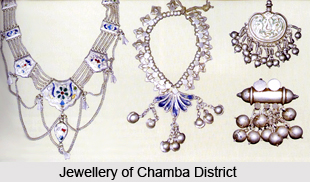 Crafts of Chamba District reflect the rich culture and tradition of the district. Several art and crafts are popular in this district of Himachal Pradesh. Like for instance, metal craft, wood carving, painting, basket making, Chamba rumal embroidery, pottery or earthenware, weaving and leather works are some of the main crafts of Chamba District. These are practiced by a huge number of local people. Moreover, art and crafts of Chamba District also draw the attention of the travellers.
Crafts of Chamba District reflect the rich culture and tradition of the district. Several art and crafts are popular in this district of Himachal Pradesh. Like for instance, metal craft, wood carving, painting, basket making, Chamba rumal embroidery, pottery or earthenware, weaving and leather works are some of the main crafts of Chamba District. These are practiced by a huge number of local people. Moreover, art and crafts of Chamba District also draw the attention of the travellers.
One of the most interesting crafts of Chamba District is the art of metal craft. The tradition of bronze casting was introduced by the Kashmiri artisans. Kashmiri influence on these Chamba bronzes is cleanly discernible. Lakshmi, Ganesh and Narsimha bronze statues in Bharmaur and Harirai and Gauri Shankar at Chamba are the marvels of the Bronze Sculptures. The method of casting of images in Chamba is Cire Perdu. The image is first made in wax and then a thin coating of clay is given to the wax model, keeping a hole for pouring the metal in. After burning the clay-covered mould, the melted metal is poured in the hollow of the mould and hence images are assumed. Some crafts persons still, are practicing the art of metal craft in Chamba.
The Chamba mural embroidery conjures up an image of a finely embroidered miniature painting. The tradition of Chamba rumal has been practiced in Chamba and neighbouring states. In the mid eighteenth century when the art of painting was at its zenith, the women started embroider the figurative motifs. With the course of time this craft was developed in Chamba and flourished in the adjoining areas. The stitch employed in the embroidery is called `Do-rukha` means double satin stitch which comes out exactly identical on the both sides. In the past, female members of the noble families in Chamba used to embroider the rural. Some times these murals were also gifted to the deities in the temples. Rasa Mandala was the famous theme of the rural embroidery however, hunting, Nayika Bhed, and Mahabharata were other popular themes. Interestingly, the tradition of Chamba rural is still alive in Chamba.
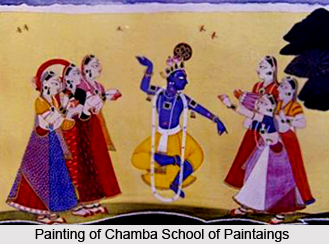 The tradition of woodcarving goes back to 7th and 8th centuries AD. The temples of Lakshana Devi in Bharmaur and Shakti Devi in Chattrari are embellished with highly intricate woodwork done in a classical manner of the post Gupta period. Deodar wood is chiefly employed for wooden architecture of the temples as well as local houses. Later wooden temples of seventeenth century are also decorated with figurative kind of work, displaying the strong influences of the Chamba School of painting. Some devil masks are also preserved in Chamba museum which were used in dance in temple complex of Chattrari. There are several temples in Chamba town that are famous for their exquisite wooden relieves depicting the themes of Hindu mythology and folklore.
The tradition of woodcarving goes back to 7th and 8th centuries AD. The temples of Lakshana Devi in Bharmaur and Shakti Devi in Chattrari are embellished with highly intricate woodwork done in a classical manner of the post Gupta period. Deodar wood is chiefly employed for wooden architecture of the temples as well as local houses. Later wooden temples of seventeenth century are also decorated with figurative kind of work, displaying the strong influences of the Chamba School of painting. Some devil masks are also preserved in Chamba museum which were used in dance in temple complex of Chattrari. There are several temples in Chamba town that are famous for their exquisite wooden relieves depicting the themes of Hindu mythology and folklore.
The activity of painting in Chamba continued in to the nineteenth century and Sikh influence in the colours, facial features and dresses of the figure can be seen in the paintings executed in the last quarter of 18th century. Bangdwari is one such traditional painting work, which is done on the either sides of a door during wedding ceremony in Chamba. Several figures of Hindu Gods and Goddess together with Lord Ganesha at top are still painted in this ritual painting.
Basket manufacturing is intimately connected with daily life of all Pahari people. It is one of the most widely practiced craft in Chamba also. Various functional objects like sturdy bowls, trays and baskets of different shapes and sizes with graceful handles are being manufactured here. The large conical basket known as kilta or kultu in common parlance, is required by all farmers for carrying heavy loads. Baskets are also used for storing food grains and other household articles. Besides these, fans, pinjras (cage) and chhatroru (umbrella) are also made. Basket-making craft is mainly done by the traditional professionals. They work on bamboo grass or seed willow branches. The grass used in Chamba for the purpose is known as `niru` which is short, fine dull, green and growing abundantly in Bharmaur and Chamba. Attractive cushions are also prepared with this grass.
Pottery is another very popular craft of Chamba District. Pots of different kinds and sizes are made out of clay. The clay is abundantly available in Chamba as elsewhere in the state. Toys of different types for entertainment and earthen lamps for lighting purpose are also being made. Some of these pots bear different kinds of paintings, motifs, decorations and floral designs. Weaving in Chamba like in other hilly districts is one of the most important craft which evolved into an extremely fascinating craft. Chamba is famous for hand made chappals. The striking feature of Chamba chappal is the embroidery done on them. The embroidery is done with silk and golden threads. Leather embroidered belts are also commonly worn by the local people. These are some of the prominent crafts of Chamba District.



















